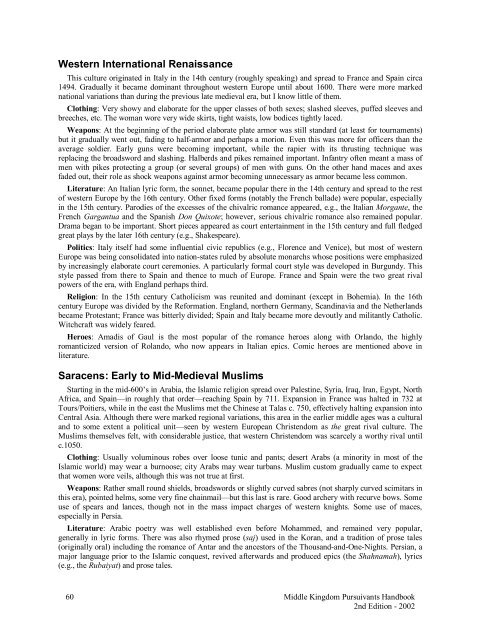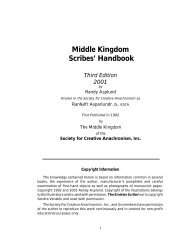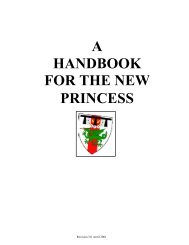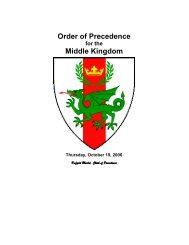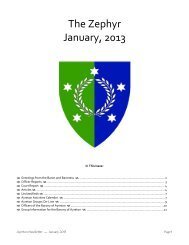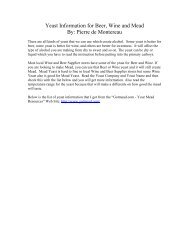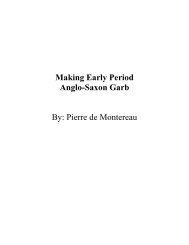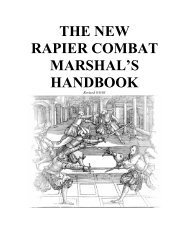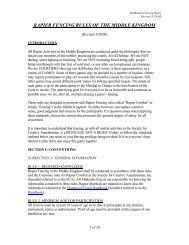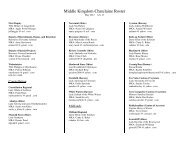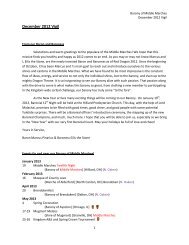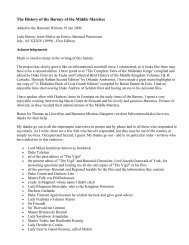Western International RenaissanceThis culture originated in Italy in the 14th century (roughly speaking) and spread to France and Spain circa1494. Gradually it became dominant throughout western Europe until about 1600. There were more markednational variations than during the previous late medieval era, but I know little of them.Clothing: Very showy and elaborate for the upper classes of both sexes; slashed sleeves, puffed sleeves andbreeches, etc. The woman wore very wide skirts, tight waists, low bodices tightly laced.Weapons: At the beginning of the period elaborate plate armor was still standard (at least for tournaments)but it gradually went out, fading to half-armor and perhaps a morion. Even this was more for officers than theaverage soldier. Early guns were becoming important, while the rapier with its thrusting technique wasreplacing the broadsword and slashing. Halberds and pikes remained important. Infantry often meant a mass ofmen with pikes protecting a group (or several groups) of men with guns. On the other hand maces and axesfaded out, their role as shock weapons against armor becoming unnecessary as armor became less common.Literature: An Italian lyric form, the sonnet, became popular there in the 14th century and spread to the restof western Europe by the 16th century. Other fixed forms (notably the French ballade) were popular, especiallyin the 15th century. Parodies of the excesses of the chivalric romance appeared, e.g., the Italian Morgante, theFrench Gargantua and the Spanish Don Quixote; however, serious chivalric romance also remained popular.Drama began to be important. Short pieces appeared as court entertainment in the 15th century and full fledgedgreat plays by the later 16th century (e.g., Shakespeare).Politics: Italy itself had some influential civic republics (e.g., Florence and Venice), but most of westernEurope was being consolidated into nation-states ruled by absolute monarchs whose positions were emphasizedby increasingly elaborate court ceremonies. A particularly formal court style was developed in Burgundy. Thisstyle passed from there to Spain and thence to much of Europe. France and Spain were the two great rivalpowers of the era, with England perhaps third.Religion: In the 15th century Catholicism was reunited and dominant (except in Bohemia). In the 16thcentury Europe was divided by the Reformation. England, northern Germany, Scandinavia and the Netherlandsbecame Protestant; France was bitterly divided; Spain and Italy became more devoutly and militantly Catholic.Witchcraft was widely feared.Heroes: Amadis of Gaul is the most popular of the romance heroes along with Orlando, the highlyromanticized version of Rolando, who now appears in Italian epics. Comic heroes are mentioned above inliterature.Saracens: Early to Mid-Medieval MuslimsStarting in the mid-600’s in Arabia, the Islamic religion spread over Palestine, Syria, Iraq, Iran, Egypt, NorthAfrica, and Spain—in roughly that order—reaching Spain by 711. Expansion in France was halted in 732 atTours/Poitiers, while in the east the Muslims met the Chinese at Talas c. 750, effectively halting expansion intoCentral Asia. Although there were marked regional variations, this area in the earlier middle ages was a culturaland to some extent a political unit—seen by western European Christendom as the great rival culture. TheMuslims themselves felt, with considerable justice, that western Christendom was scarcely a worthy rival untilc.1050.Clothing: Usually voluminous robes over loose tunic and pants; desert Arabs (a minority in most of theIslamic world) may wear a burnoose; city Arabs may wear turbans. Muslim custom gradually came to expectthat women wore veils, although this was not true at first.Weapons: Rather small round shields, broadswords or slightly curved sabres (not sharply curved scimitars inthis era), pointed helms, some very fine chainmail—but this last is rare. Good archery with recurve bows. Someuse of spears and lances, though not in the mass impact charges of western knights. Some use of maces,especially in Persia.Literature: Arabic poetry was well established even before Mohammed, and remained very popular,generally in lyric forms. There was also rhymed prose (saj) used in the Koran, and a tradition of prose tales(originally oral) including the romance of Antar and the ancestors of the Thousand-and-One-Nights. Persian, amajor language prior to the Islamic conquest, revived afterwards and produced epics (the Shahnamah), lyrics(e.g., the Rubaiyat) and prose tales.60 <strong>Middle</strong> <strong>Kingdom</strong> <strong>Pursuivants</strong> <strong>Handbook</strong><strong>2nd</strong> <strong>Edition</strong> - 2002
Politics: The entire Islamic world originally recognized the authority of the caliph (the successor of theProphet) who wielded very broad power until the 10th century. Thereafter the caliph’s power becamenominal—they still granted titles and issued diplomas legitimizing local rulers, but these were only approvingchanges they could not control. The most powerful of the rulers who had real power usually used the title“Sultan” (which actually means ‘power’). Rulers were in theory absolute though they might have to defer inpractice to bodyguards, ambitious governors, or the ulema (assembly of Muslim scholars)Religion: The religion for Saracens is Islam. In the generation after Mohammed, Islam split over the issue ofwho was the prophet’s rightful successor. The majority (Sunni—the acceptors of the ‘tradition’) felt thecaliphate should go (in theory) to any pious Muslim, in practice this meant first, four of Mohammed’s earlycompanions, then two dynasties of his distant kinsmen, the Umayyads and the Abbasids. The minority groupfelt the rightful caliph (they preferred to say imam) was the direct descendant of the Prophet—first his son-inlawAli, then Ali’s sons and their descendants. Those holding this view were the Shiat Ali (‘party of Ali’), orShia for short. They rarely attained more than local power (aside from the Fatimids in Egypt); but were popularamong some intellectuals, poets and assassins.It should also be remembered that in the early centuries the Muslims were a ruling elite—many of theirsubjects were Christians. In Iran there also survived a minority of ‘Gebers,’ i.e., Zoroastrians, suspected of allsorts of depraved practices by the Muslims. Jews were usually tolerated in Islam (on payment of tax) as werethe Christian heretics (e.g., Nestorians) and these often cooperated loyally with the Muslims.Heroes: Pre-Islamic: Antar, Islamic, Mohammed himself, Ali and his companions. Later historical figuressuch as Harun al-Rashid and Saladin became legendary.Turks: Late Medieval MuslimsIn the later <strong>Middle</strong> Ages, the ruling elite in much of the Muslim world was Turkish. The Turks began asCentral Asian nomads who gradually gained influence in the Islamic culture area from the 9th century on,becoming the dominant group by the 11th century. At first they were soldiers, often nominally slaves of theirmasters (who were Arabs or Persians). Later they became rulers (usually Sultans) in their own right, nominallyauthorized by the late caliphs. The two great Turkish dynasties were the Seljuks (who ruled much of what isnow Turkey, Syria, Iraq and Iran in the 11th century) and the Osmanli (Ottomans) who ruled an empire based inTurkey but including for most of its existence Syria, parts of Iraq, the coast of North Africa (as overlords of the“Barbary Corsairs”) and much of Eastern Europe. This empire was created in the 14th and 15th centuries andlasted (with various gains and losses) down to the First World War. Other states, notably the Mongol empire ofthe 13th century and some of its successor states, had a substantial ethnic Turkish element.Clothing: As with the Arabs, robes over pants and tunics. The distinctively Turkish headgear was considered(by Europeans) to be the fez, but turbans and other forms were worn. The Janissaries (famous Ottoman slavesoldiers)wore a very distinctive hat with a sleeve dangling from it (representing a sleeve of the dervish whowas said to have blessed the corps in its early days). Women were usually heavily veiled in public—later Islamwas in many ways more rigid than the earlier forms. European imaginations ran riot over how little the womenmight wear in the privacy of the harem.Weapons: Powerful recurve bows, scimitars, spears (used by the Janissaries). The Osmanli were among thefirst states to make major use of gunpowder (in huge clumsy cannons) for sieges.Literature: Much of the literary life of the day in Islamic cultures as still conducted in Arabic or Persian—the Turkish Sultan Mohammed the Conqueror is supposed to have quoted a Persian poet when enteringConstantinople in triumph, for example. An actual Turkish literature did gradually arise.Politics: See introductory remarks—the basic pattern was usually a sultan who nominally ruled by approvalof the religious authorities and perhaps by hereditary right, but in fact lasted as long as he had reliable militarysupport. Armies of slave-soldiers like the Mamelukes and Janissaries tended to be king-makers—theMamelukes in effect ruled as a military dynasty in Egypt from the late 1200s to the early 1500s. A sultan wasgenerally absolute ruler for as long as he lasted, but the drop from unquestioned monarch to mutilated corpsewas frequently swift. Some outlying areas (e.g., North Africa under the Ottomans) might be semi-independentvassal states.<strong>Middle</strong> <strong>Kingdom</strong> <strong>Pursuivants</strong> <strong>Handbook</strong> 61<strong>2nd</strong> <strong>Edition</strong> - 2002
- Page 2:
Middle Kingdom Pursuivants Handbook
- Page 5 and 6:
INTRODUCTION.......................
- Page 7 and 8:
Saracens: Early to Mid-Medieval Mus
- Page 9 and 10:
IntroductionOsric of FayrehopeWhat
- Page 11 and 12:
AcknowledgementsMistress Elena de V
- Page 13 and 14:
The Middle KingdomCollege of Herald
- Page 15 and 16:
Regional HeraldsConstellation Heral
- Page 17 and 18:
Pursuivant DutiesDuties of the Bran
- Page 19 and 20:
All submissions should be sent to t
- Page 21 and 22: What to Report?First of all, your r
- Page 23 and 24: esponsibility now. It wouldn’t hu
- Page 25 and 26: simply too pervasive. Chilly weathe
- Page 27 and 28: switched into the losers’ bracket
- Page 29 and 30: prevent accusations of a rigged lis
- Page 31 and 32: the green fabric), a larger spool o
- Page 33 and 34: Precedence and CourtesyCourtly Beha
- Page 35 and 36: Territorial Barons and Baronesses m
- Page 37 and 38: c. Once all presentations appear to
- Page 39 and 40: i. Oaths of Fealty and Acknowledgem
- Page 41 and 42: herald is the voice of the Crown an
- Page 43 and 44: Award of the Dragon's FlightOP Abbr
- Page 45 and 46: Award of ArmsOP Abbreviation - AoAL
- Page 47 and 48: Order of the Red CompanyOP Abbrevia
- Page 49 and 50: Order of the WillowOP Abbreviation
- Page 51 and 52: Order of the Gold MaceOP Abbreviati
- Page 53 and 54: Master of ArmsOP Abbreviation - MSC
- Page 55 and 56: Prince and Princess of NorthshieldO
- Page 57 and 58: - The Consort of Northshield bears
- Page 59 and 60: The Submission ProcessWorking with
- Page 61 and 62: A good consultant will have these e
- Page 63 and 64: submit it anyway (“I may be wrong
- Page 65 and 66: Internal Letter Of Acceptance And R
- Page 67 and 68: NamesOn Names and Name Documentatio
- Page 69 and 70: Choosing a CultureJehan de la March
- Page 71: Clothing: For the Slavic groups, pr
- Page 75 and 76: Although in the earlier Middle Ages
- Page 77 and 78: character in Household’s Arabesqu
- Page 79 and 80: An Extremely Brief BibliographyWest
- Page 81 and 82: ArmoryThe Philosophical Roots of He
- Page 83 and 84: Even if your natural instinct for a
- Page 85 and 86: 5. Peripheral secondary charges.6.
- Page 87 and 88: Brisures (marks of cadency) and aug
- Page 89 and 90: Still found in mundane blazons are
- Page 91 and 92: Efficient Conflict ResearchKeridwen
- Page 93 and 94: 1. Is there a peripheral charge (a
- Page 95 and 96: checking under the old rules, the s
- Page 97 and 98: 2. Yes, the peripheral is charged.
- Page 99 and 100: Many authors state that dancetty is
- Page 101 and 102: Charges may be placed on either sid
- Page 103 and 104: It’s a bit more complicated to ke
- Page 105 and 106: This page shows properly drawn exam
- Page 107 and 108: This page shows a number of common
- Page 109 and 110: Postures of Animals (cont’d)Posit
- Page 111 and 112: Postures of BirdsPosition & Comment
- Page 113 and 114: Postures of Fish and DolphinsPositi
- Page 115 and 116: Barony of Caer Anterth MawrAzure, a
- Page 117 and 118: Barony of the North WoodsAzure, a w
- Page 119 and 120: Shire of AfonlynAzure, on a bend ar
- Page 121 and 122: Shire of Rivenwood TowerErmine, on
- Page 123 and 124:
Reference BooksThe Basic HeraldBron
- Page 125 and 126:
Bardsley, Charles Wareing. English
- Page 127 and 128:
Kaganoff, Benzion C. A Dictionary o
- Page 129 and 130:
Sims, Clifford Stanley. The Origin
- Page 131 and 132:
Moncreiffe, Iain, and Don Pottinger
- Page 133 and 134:
Bruce Draconarius of Mistholme and
- Page 135 and 136:
Rules and RegulationsRules for Subm
- Page 137 and 138:
Although China, Random and Starhawk
- Page 139 and 140:
iii. Heraldic Titles - Heraldic tit
- Page 141 and 142:
ii. Number of Name Phrases - A pers
- Page 143 and 144:
PART VII - COMPATIBLE ARMORIAL CONT
- Page 145 and 146:
i. A metal and a color;ii. An eleme
- Page 147 and 148:
PART IX - OFFENSIVE ARMORYOffensive
- Page 149 and 150:
ii. Field-Primary Armory - If neith
- Page 151 and 152:
j. Changes to Charges on Charges -
- Page 153 and 154:
3. Marshalling. - Armory that appea
- Page 155 and 156:
directly by individuals, but may be
- Page 157 and 158:
the Laurel Office from the registra
- Page 159 and 160:
charge or augmentation is transferr
- Page 161 and 162:
so that ð is alphabetized as dh,
- Page 163 and 164:
1. Failure to Comment. Failure to c
- Page 165 and 166:
B. Content of Letters of Acceptance
- Page 167 and 168:
1. Principal Heralds - The Principa
- Page 169 and 170:
1. Financial Reports - Financial re
- Page 171 and 172:
Appendix B - Standard Designations
- Page 173 and 174:
Appendix D - Suggested Standard For
- Page 175 and 176:
Appendix G - Role of the Deputy Sov
- Page 177 and 178:
Glossary of TermsThis glossary was
- Page 179 and 180:
Complement, In Her*—Describes the
- Page 181 and 182:
Fur—Some furs, like Vair, Potent
- Page 183 and 184:
Mon—Japanese armorial insignia†
- Page 185 and 186:
Registration—Acceptance by Laurel
- Page 187 and 188:
AppendicesSources for Heraldic Publ
- Page 189 and 190:
• Send the four copies in and kee
- Page 191 and 192:
“Major” or “minor” changes?
- Page 193 and 194:
See the General section at the begi


